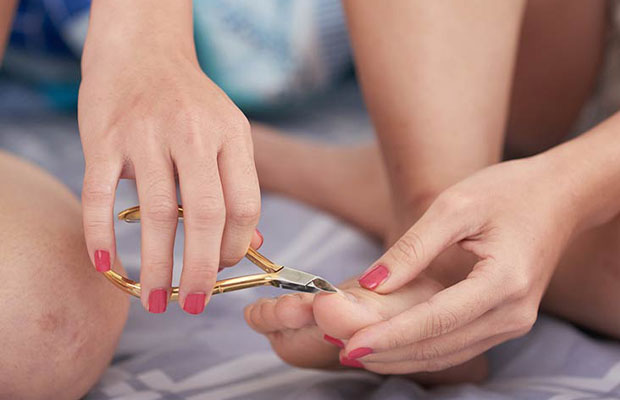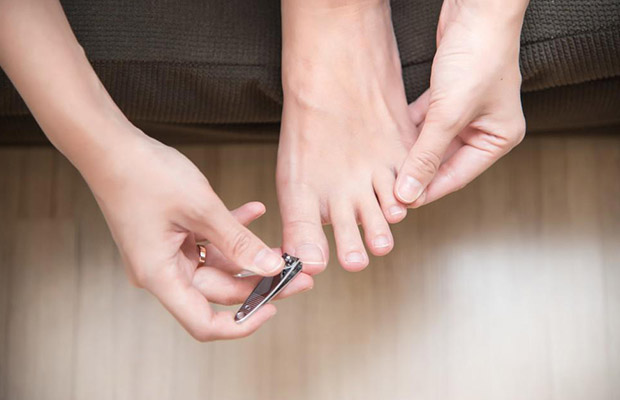How To Cut Toenails? Dos and Don’ts You Should Know

Even though it seems straightforward, maintaining good foot health requires proper toenail trimming and filing.
Knowing how to cut toenails properly is crucial to avoiding painful ingrown toenails, a condition in which the toenail curves and grows into the skin, frequently resulting in pain and occasionally infection.
This guide introduces how to cut toenails and the dos and don’ts that you should pay attention to. Let’s start!
Table of Contents
How To Cut Toenails?
1. Nail Clippers
Utilizing the proper nail-cutting instrument is the first step. Manicure scissors or nail clippers work well. Avoid using items like common scissors or knives that aren’t made for cutting nails.
One nail clipper for your fingers and one for your toes should be in your possession. Your toenails need a bigger clipper because they are thicker and wider. Additionally, by using separate clippers, you lessen the possibility of spreading bacteria or fungus between your hands and feet. A thorough cleaning should be performed after each use of your clippers.
2. Cut Frequency
The frequency of cutting is the next step. It is appropriate to trim your toenails every six to eight weeks as they typically grow 2 millimeters (0.08 inches) per month. In light of this, it is likely that trimming them more frequently will make you more comfortable if you are a very active person or athlete—especially a runner.
3. Cutting Wet Or Dry Nails
Responding to a typical query is the third step: “When should I trim my nails—after taking a shower or before?” The majority of the time, the response is “before.” You will get a cleaner cut if your toenails are dry because they won’t bend or tear as easily.
Cutting will be simpler following a shower for those with very thick toenails.
4. Time Between Cuts
Choosing the length of time to wait after cutting your toenails is the fourth step. Cutting your toenails too short may increase your risk of developing ingrown toenails, so this is crucial. Your toenails are more likely to tear if you wait too long to trim them.
Your toenails should be kept between one and two millimeters long (0.04 and 0.08 inches).
5. Cutting The Nail
The actual cut is made in the fifth step. Cut your toenails across the middle to prevent uncomfortable ingrown toenails. For many people, it is simplest to complete this task in two cuts: the first, where the clippers are placed just off the side of the nail to create a straight edge, and the second, where the remaining nail is removed along the line of the straight cut.
6. Filing The Nail
The sixth and final step is to file your nails with an emery board to remove any sharp edges that might catch and possibly tear the nail as it grows.
Related Reading: How Long Does It Take for a Toenail to Grow Back?

How To Cut Thick Toenails?
Your toenails may be thick for a variety of reasons, such as:
- fungal infection, such as onychomycosis
- psoriasis, a skin condition that causes rapid cell build-up on the skin’s surface
- injury
- tight-fitting shoes
Observe these steps to properly trim your thick toenails:
- To soften your toenails, soak your feet in warm water for at least 10 minutes. After that, thoroughly dry your feet and toenails with a towel.
- Cut straight across with a nail clipper while making small cuts to prevent nail splintering. Don’t round off the corners to reduce the possibility of the nail growing inward.
- To avoid snagging, emery the edges and corners with a board.
Ask your doctor for advice if your thickened toenails hurt or you’re unsure about whether you can safely trim them without assistance.
How To Cut Toenails With Fungus?
It is similar to how thick toenails are cut to cut toenails that have fungus. Your nails will continue to thicken if the fungus is not treated, and they may eventually reach a point where additional action is necessary, such as:
- medical-grade toenail clippers, as standard clippers may not be able to cut all the way through and can slip off the nail and cut your skin
- longer foot soak (20 or 30 minutes in warm water)
- clipper disinfection using alcohol or diluted bleach
Make an appointment with your doctor if you believe you have a fungal infection.
Dos And Don’ts When Cutting Toenails
Dos
File Sharp Or Jagged Edges
The next step is crucial. To make sure the nail edge is smooth, always file any sharp corners or jagged edges. Sharp edges can snag on socks or even stab the skin nearby. This guarantees that you won’t leave a nail spike behind that will irritate the skin and result in an excruciating ingrown toenail.
Wash And Dry Your Feet First
To maintain proper hygiene, you should wash your feet at least once a day. Either your feet are directly on the ground or very near it, enclosed in a pair of shoes. Due to these conditions, they are much more likely to come into contact with dangerous bacteria and fungi. Your tools won’t slip and you’ll be able to clearly see the nail edge if you thoroughly dry your feet.
Have The Right Tool Available
You will require a pair of precise nail clippers or, if your nails are particularly thick, professional nail nippers, to trim your toenails. A nail file is also required.
Clip Nails Straight Across
The safest way to trim a toenail is to cut it straight across. The toenail will continue to grow forward as a result.
Don’ts
Wait Too Long Between Trimming Toenails
Toenails still need to be regularly trimmed even though they do not grow as quickly as fingernails. Every eight weeks or less, you should trim your toenails. In addition to being uncomfortable in socks and closed-toe shoes, having long toenails increases the chance that they will break or crack, which raises the possibility of infection.
Trim The Nails Too Short Or Too Deep
In order to prevent the nail from growing into the skin rather than on top of it, the skin around the nail should not be higher than the toenail. Instead, the nail should only be scraped along the skin’s edge and not any further. Too short of a nail cut can also expose the nail bed, which is very tender.
Rip, Peel, Or Bite Your Toenails
To “trim” your toenails with your fingers or any other body part is extremely risky and unsanitary!). In most cases, the nail is left too short, jagged, and removed too deeply when you do this because you have very little control over the situation.
Use Dirty Tools
Use rubbing alcohol to clean your tools frequently, or if they are disposable, regularly replace them. Using instruments that are contaminated with germs and bacteria can be risky, particularly if you nick your skin unintentionally or develop an ingrown toenail.
Don’t put off visiting a qualified chiropodist if you think you might have a problem with one of your toenails, especially if you also have other medical issues like diabetes. A chiropodist will be able to evaluate the issue and look into the best available treatments.
Is It Necessary To Soften Your Toenails?
Is the typical thickness of your toenails such that it requires a lot of force to cut them with clippers?
If you don’t have to, resist the urge to force the matter. Because of this, it may be all too simple to slip while using your nail clippers and hurt yourself or tear your nails.
Instead, try working on your toenails after taking a shower or bath, when the nail tissue tends to be softer and perhaps easier to work with. The process of cutting your nails can be much easier, and you get the added benefit of having clean feet before starting work! To lessen the chance of slipping, just make sure your feet are completely dry before you begin clipping.
That being said, if you normally clip your toenails with no problems, don’t attempt to do so right after a shower or bath. There is such a thing as your nails being too soft to work with, and trying to clip them at this time may lead to tearing.
Do You Need Assistance With Your Nail Issues?
Your feet can look and feel great for a long time with the help of good nail-trimming habits, but occasionally there are other issues that require professional assistance.
Please don’t hesitate to call us about any of the following conditions if you are experiencing them.
- Painful ingrown toenails (especially if you suspect an infection)
- Recurring ingrown toenails (even after you change your trimming habits)
- Fungal infections (thick, brittle, crumbly, and even unpleasant smelling nails)
- Black or otherwise discolored toenails
- Nails that are falling off
Final Thoughts
There is no set frequency for trimming toenails because everyone’s nails grow at a different rate. Simply keep an eye on how long your nails are and trim them before they begin to hurt from rubbing against your shoes.
Use the right equipment, cut your toenails straight across the nail, and make sure to clean your tools well after each use if you want to do it right. Take extra care when trimming your nails if you have toenails that are unusually thick or if you have toenail fungus.
Comfortable, healthy feet are the result of clean, well-maintained toenails that are neatly trimmed. Keep toes properly trimmed on a regular basis to avoid foot problems because your feet take a beating throughout the day. It is frequently necessary to discuss foot care with your doctor.
Read More: What Causes A Black Toenail?
Tags: Cut Toenails